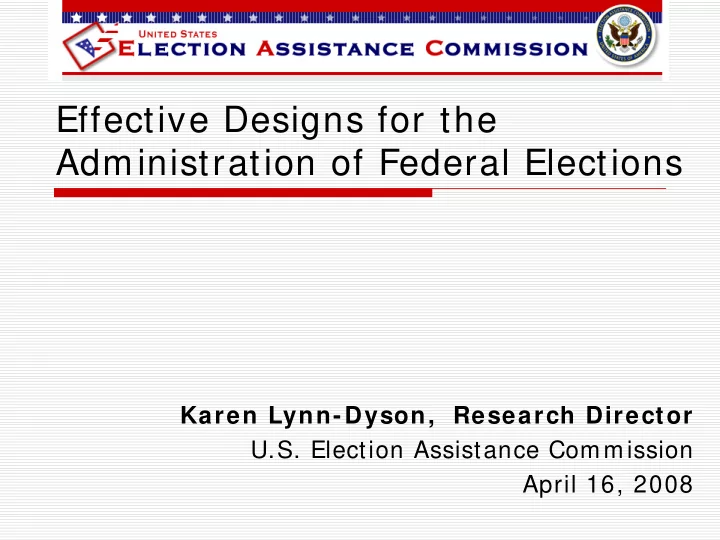

Effective Designs for the Administration of Federal Elections Karen Lynn-Dyson, Research Director U.S. Election Assistance Commission April 16, 2008
Background HAVA 241(b)(2) and 302(b) mandate that EAC study ballot designs for elections for Federal Office. Based on research from May 2006- January 2007, EAC released “ Effective Designs for the Administration of Federal Elections ” in July 2007.
Background Study based on 10 research events Observed 4 rural and urban primary elections in Nebraska and New Jersey Conducted field interviews with voters, poll workers and administrators Consulted with experts LEOs, 20 literacy instructors, manufacturers Conducted 54 usability evaluations in 7 states, with more than 44 representative voters
Planning Election Design Changes Election Official needs to: Establish a baseline for future improvements by evaluating current election & getting voter feedback before & after election Establish an approval process for election design changes Estimate the value & impact of design changes Emphasize voter needs over administrative & vendor requirements
Planning Election Design Changes Election Official needs to consult with: A Simple Language Expert – someone who can edit language content for low-literacy voters A Designer – someone familiar with poll worker practices who will oversee ballot design process A Usability Expert – someone who will ensure that the voting process is clear and easy to understand A Translator – someone to translate content for non-English speakers A Cultural Expert – someone who will check ballot materials for cultural relevance A Policy Advisor – someone who can help jurisdiction navigate legal & PR issues pertaining to ballot design changes
Critical Design Elements Language and Content: Use clear, simple language Use one (maximum two) languages per ballot Provide summaries for long ballot measures When transliterating names, consultation with a language expert is recommended in order to avoid overtly positive or negative meanings in sound-based characters Text Use and Size: Use a minimum of 12 point san-serif font, with 2 point line spacing, left-aligned, upper and lower case letters The Univers type font is common, consistent, and readable Use only 40-60 characters per line All candidates in a contest should be given the same amount of vertical space. If a candidate’s name must break onto a second line, the vertical space for all candidates should be changed to match
Critical Design Elements Color: Use just one color for instructions on optical scan ballots Cyan is recommended Titles in white against colored background are easiest to read Use colors to emphasize important info If color can not be used, change all colored areas to 10% black Icons and Graphics: Using instructive symbols like or can be helpful to less literate voters Political party icons are often confusing to voters Illustrative diagrams should accurately reflect the ballot type & voting equipment
Printing HAVA-Mandated Signs HAVA mandates several items be posted at polling place Fabrication time varies 7-14 days: Voter’s Bill of Rights; Sample Ballots (for doors, walls, and tabletops); Voting Instructions (for booths); Precinct Identification & Polling Place Information
Printing HAVA-Mandated Signs 5-6 days: Special Voting Rules; Voting Instructions 2-3 days: ‘Vote Here’ Banner; Vote by Touchscreen; Return Ballot Immediate: ‘Vote Here’ Door Sign; Election Official Stickers; Accessible Entrance Door Signs
Ballot Design Principles for Different Machine Types Optical Scan Ballots Include page number out of total pages in multipage ballots, ie page ‘2 of 5’ Selections should be marked into an oval to the left of candidate names When ballots are in more than one language, print English name of language, ie ‘Cantonese’ or ‘Mandarin’ Ballots should have 40-60 characters per line and use at least 12 point font Embedding ballot instructions in ballots supports greater focus and autonomy for users Ballot instructions should be self-contained and separated from contest data
Ballot Design Principles for Different Machine Types Principles for both Full Face DRE & Rolling DRE machines: Ensure that screen settings for language choices, text size, contrast & audio support are readily available and easy to change Ensure that voters can easily review and change their votes at any point in the ballot Use upper and lowercase sans serif type at a minimum size of 25 points Avoid using center alignment, all capital letters, or multiple fonts
Ballot Design Principles for Different Machine Types Full Face DRE Consideration should be given to candidate name order being rotated from precinct to precinct, so that all candidates will be listed first in roughly an equal number of precincts Information about the specific election (ie, date, county) should be placed above the left column of every ballot page. Including instructive phrases like ‘Vote for 1 pair’ or ‘Vote for up to 5’ at the top of ballot sections is a recommended best practice
Ballot Design Principles for Different Machine Types Rolling DRE Ballot First, present voters with the choice of their preferred language before they begin voting Direct voters next to a welcome screen which allows them to: a) begin voting, b) learn how to use the ballot, c) see a list of the questions, d) change screen settings Allow voters to use a “skip” button if they wish to first vote in a different contest When a voter makes a choice, their choice should be highlighted and a checkmark should appear.
Ballot Design Principles for Different Machine Types Rolling DRE Ballot ‘Vote counters’ should be located on the left hand size which alert the voter to the number of votes remaining in a given contest. Ex) Voter has 5 votes for city council, he/ she selects one, vote counter should read ‘4’ For lengthy candidate lists, a brightly colored bar should appear at the bottom of the screen which reads ‘touch here to see additional candidates’ Before submitting their ballot, voters should be able to visit a ‘review screen’ from which they can print their selections
Recommend
More recommend